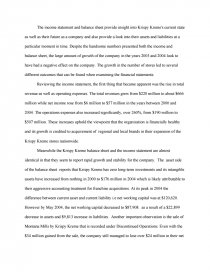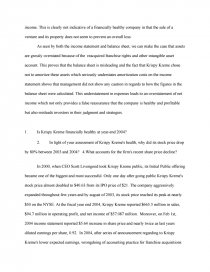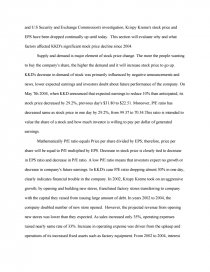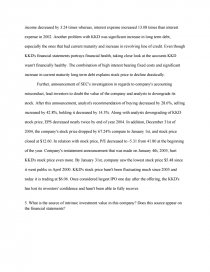Case Assignments 3
Essay by Paul • June 18, 2012 • Essay • 1,270 Words (6 Pages) • 2,421 Views
The income statement and balance sheet provide insight into Krispy Kreme's current state as well as their future as a company and also provide a look into their assets and liabilities at a particular moment in time. Despite the handsome numbers presented both the income and balance sheet, the large amount of growth of the company in the years 2003 and 2004 look to have had a negative effect on the company. The growth in the number of stores led to several different outcomes that can be found when examining the financial statements.
Reviewing the income statement, the first thing that became apparent was the rise in total revenue as well as operating expenses. The total revenues grew from $220 million to about $666 million while net income rose from $6 million to $57 million in the years between 2000 and 2004. The operations expenses also increased significantly, over 260%, from $190 million to $507 million. These increases uphold the viewpoint that the organization is financially healthy and its growth is credited to acquirement of regional and local brands in their expansion of the Krispy Kreme stores nationwide.
Meanwhile the Krispy Kreme balance sheet and the income statement are almost identical in that they seem to report rapid growth and stability for the company. The asset side of the balance sheet reports that Krispy Kreme has zero long-term investments and its intangible assets have increased from nothing in 2000 to $176 million in 2004 which is likely attributable to their aggressive accounting treatment for franchise acquisitions. At its peak in 2004 the difference between current asset and current liability i.e net working capital was at $120,620. However by May 2004, the net working capital decreased to $87,908. as a result of a $22,899 decrease in assets and $9,813 increase in liabilities. Another important observation is the sale of Montana Mills by Krispy Kreme that is recorded under Discontinued Operations. Even with the $34 million gained from the sale, the company still managed to lose over $24 million in their net income. This is clearly not indicative of a financially healthy company in that the sale of a venture and its property does not seem to prevent an overall loss.
As seen by both the income statement and balance sheet, we can make the case that assets are grossly overstated because of the reacquired franchise rights and other intangible asset account. This proves that the balance sheet is misleading and the fact that Krispy Kreme chose not to amortize these assets which seriously understates amortization costs on the income statement shows that management did not show any caution in regards to how the figures in the balance sheet were calculated. This understatement in expenses leads to an overstatement of net income which not only provides a false reassurance that the company is healthy and profitable but also misleads investors in their judgment and strategies.
1. Is Krispy Kreme financially healthy at year-end 2004?
2. In light of your assessment of Krispy Kreme's health, why did its stock price drop by 80% between 2003 and 2004? 4.What accounts for the firm's recent share price decline?
In 2000, when CEO Scott Livengood took Krispy Kreme public, its Initial Public offering became one of the biggest and most successful. Only one day after going public Krispy Kreme's stock price almost doubled to $40.63 from its IPO price of $21. The company aggressively expanded throughout few years and by august of 2003, its stock price reached its peak at nearly $50 on the NYSE. At the fiscal year end 2004, Krispy Kreme reported $665.5 million in sales, $94.7 million in operating profit, and net income of $57.087 million. Moreover, on Feb 1st, 2004 income statement reported $5.64 increase in share price and nearly twice as last years diluted earnings per share, 0.92. In 2004, after series of announcement regarding to Krispy
...
...



